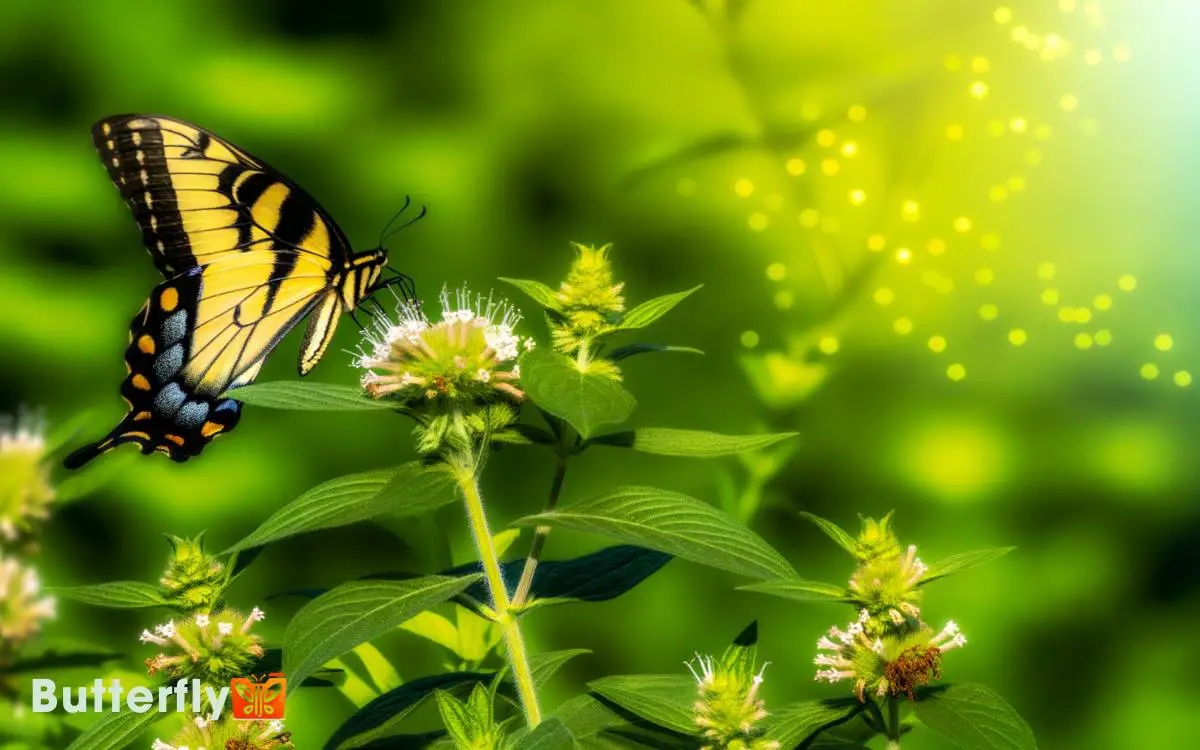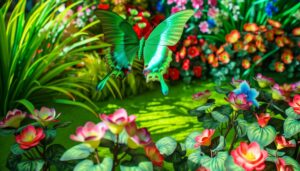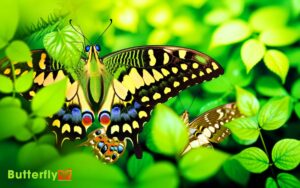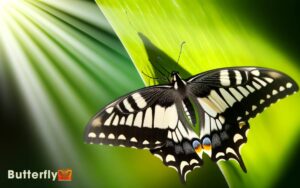Eastern Tiger Swallowtail Butterfly Symbolism: Explanation!
The Eastern Tiger Swallowtail butterfly symbolizes transformation, resilience, and adaptability, reflecting its profound metamorphic stages from egg to adult.
In cultural narratives, it epitomizes personal growth, freedom, and the pursuit of change. Its vivid black and yellow hues inspire artistic expressions, while its symmetrical wing patterns embody natural beauty.
Spiritually, this butterfly represents renewal and the soul’s journey, with its striking colors symbolizing enlightenment and balance. Its presence often signals hope, fresh beginnings, and the transformative power of nature’s cycles.
Explore further to uncover deeper symbolic interpretations and cultural significances attributed to this remarkable butterfly.

Key Takeaways
Cultural Significance
In various cultures, the Eastern Tiger Swallowtail butterfly (Papilio glaucus) holds significant symbolic meanings, often representing transformation, grace, and the ephemeral nature of life.
This lepidopteran, with its striking yellow and black wing patterns, commands attention and admiration.
Indigenous tribes in North America view the butterfly as an emblem of change and a harbinger of new beginnings.
In Eastern philosophical traditions, its delicate flight embodies the transient beauty of existence, reminding individuals to embrace life’s fleeting moments.
The butterfly’s metamorphosis from caterpillar to adult is also celebrated in numerous cultural narratives, underscoring themes of personal growth and renewal. By observing its life cycle, people find inspiration to pursue freedom and transformation within their own lives.
Symbol of Transformation
Through the process of metamorphosis, the Eastern Tiger Swallowtail butterfly exemplifies the profound biological transformation from larva to adult, offering a vivid model for understanding developmental biology and ecological adaptation. During its life cycle, the female Eastern Tiger Swallowtail lays eggs on host plants such as wild cherry and tulip trees, ensuring a suitable food source for the emerging larvae. As the caterpillar grows, it undergoes several molting stages before forming a chrysalis, where the remarkable metamorphic changes occur. Eventually, the adult butterfly emerges, displaying striking yellow and black markings that aid in species recognition and predator avoidance.
This metamorphosis involves critical stages: egg, larva (caterpillar), pupa (chrysalis), and adult butterfly. Each phase signifies complex physiological changes and genetic regulation.
| Stage | Key Characteristics |
|---|---|
| Egg | Tiny, spherical, laid on host plants |
| Larva | Caterpillar, feeding voraciously |
| Pupa | Chrysalis, undergoing transformation |
| Adult | Emergence, wing expansion, mating |
Researchers observe how hormonal changes govern these stages, reflecting broader themes of adaptability and survival. The butterfly’s journey from a grounded caterpillar to a free-flying adult symbolizes nature’s incredible ability to transform and adapt.
Emblem of Personal Growth
Much like the Eastern Tiger Swallowtail‘s metamorphosis, personal growth involves a series of developmental stages characterized by significant physiological and psychological changes.
As the caterpillar progresses into a chrysalis, it undergoes cellular reorganization and differentiation. This intricate process mirrors human personal development, where individuals experience cognitive restructuring, emotional maturation, and behavioral adjustments.
Each stage of the butterfly’s life cycle, from larva to adult, demands adaptive strategies and resilience, much like the human journey of growth.
Hope and New Beginnings
The Eastern Tiger Swallowtail butterfly epitomizes hope and new beginnings, symbolizing the embrace of fresh starts through its life cycle stages.
As it transforms from a caterpillar to an adult butterfly, it embodies the principles of metamorphosis, growth, and renewal.
This species signifies optimism, with its vibrant wings serving as a tangible reminder of nature’s resilience and continual cycles of change.
Embracing Fresh Starts
With its vibrant yellow wings edged in black, the Eastern Tiger Swallowtail butterfly epitomizes the essence of hope and new beginnings in various cultural and ecological contexts. This lepidopteran’s annual emergence from chrysalis to butterfly symbolizes life’s cyclical renewal.
Ecologically, it signifies the onset of spring, a period synonymous with rebirth and fresh starts. The butterfly’s intrinsic ability to navigate vast distances underscores themes of resilience and adaptation.
Its presence in diverse ecosystems highlights its role as a pollinator, contributing to floral regeneration.
For those yearning for change, the Eastern Tiger Swallowtail serves as a living demonstration of the transformative power of embracing fresh starts, offering a compelling reminder of the boundless possibilities inherent in life’s continuous journey.
Transformation and Growth
Frequently observed fluttering across meadows and gardens, the Eastern Tiger Swallowtail butterfly exemplifies transformation and growth through its complex metamorphic lifecycle, from egg to larva, pupa, and finally, adult.
Each stage signifies a unique developmental process, embodying the principles of change and adaptation.
The larval stage, for instance, involves molting and growth, while the pupal stage is characterized by biochemical transformations leading to the emergence of the adult butterfly.
This intricate process serves as a potent symbol of:
- Adaptation: Adjusting to new environments.
- Resilience: Overcoming challenges at each stage.
- Evolution: Progressive development through stages.
- Metamorphosis: Complete and profound transformation.
- Maturation: Attaining full development and potential.
These elements highlight the butterfly’s profound journey of growth and transformation.
Renewal and Optimism
Following its remarkable journey of transformation, the Eastern Tiger Swallowtail butterfly also embodies renewal and optimism, symbolizing hope and new beginnings through its emergence from the chrysalis.
Metamorphosis in this species is a precise biological process involving hormonal regulation and cellular differentiation, culminating in the adult butterfly’s eclosion.
Observers note the striking contrast between the pupal stage’s dormancy and the vibrant flight of the newly emerged butterfly. This dramatic shift exemplifies life’s potential for renewal and the optimism inherent in new beginnings.
The butterfly’s vibrant coloration and expansive wingspan serve as a visual metaphor for freedom and boundless possibilities, inspiring those who witness this natural phenomenon to embrace change and seek out new opportunities.
Artistic Inspirations
Artists frequently draw inspiration from the Eastern Tiger Swallowtail’s vibrant color palettes and intricate wing patterns, incorporating these elements into their work.
The butterfly’s distinct black and yellow hues and graceful, symmetrical designs provide a rich source for nature-inspired motifs in various artistic mediums.
Through detailed observation, artists capture the essence of this lepidopteran, translating its natural beauty into compelling visual expressions.
Vibrant Color Palettes
The Eastern Tiger Swallowtail butterfly‘s distinct yellow and black color patterns serve as a rich source of inspiration for artists seeking to incorporate nature’s vibrant palettes into their work.
This species’ striking hues aren’t just visually appealing but also demonstrate evolutionary adaptation and survival strategies.
Artists often draw upon these natural palettes to evoke contrast and balance. The sharp delineation between yellow and black offers a dynamic visual interplay.
They also use the colors to create natural harmony by incorporating complementary colors found in the butterfly’s habitat, enhancing artistic compositions.
Additionally, the symbolism of yellow often signifies joy and energy, while black can symbolize mystery and depth.
Artists can also replicate the intricate scales on the butterfly’s wings to provide a template for textural effects, adding depth and interest to their work.
Moreover, the pattern repetition seen in the markings of the butterfly aids in creating rhythm in art, allowing artists to play with the repetitive nature of the patterns to create movement and flow in their pieces.
Graceful Wing Patterns
Graceful wing patterns of the Eastern Tiger Swallowtail serve as a profound source of inspiration, showcasing symmetrical designs and intricate veining that artists meticulously study to replicate in their works.
These butterflies exhibit bilateral symmetry, displaying elongated forewings with a distinctive yellow and black coloration.
The wing veins, part of the lepidopteran wing venation system, create a framework that artists find enthralling. Detailed observation reveals subtle gradations in color intensity and texture, essential for accurate artistic representation.
The black ‘tiger stripes’ on a yellow background aren’t just aesthetically pleasing but also serve functional purposes in nature.
Artists, seeking freedom in their creative expressions, draw from these precise natural patterns to craft visually stunning and scientifically accurate representations.
Nature-Inspired Motifs
Drawing from the Eastern Tiger Swallowtail’s intricate wing patterns, nature-inspired motifs often incorporate its vivid color palettes and symmetrical designs, serving as a tribute to the butterfly’s influence on artistic creations.
Artists frequently employ these elements to evoke a sense of natural beauty and freedom.
The striking yellow and black coloration, combined with the delicate, eye-catching blue and orange spots, provides a rich source of inspiration for various artistic mediums.
Whether through textile design, graphic arts, or tattoos, this butterfly’s aesthetic elements are meticulously replicated.
- Textiles: Fabrics featuring butterfly wing patterns.
- Graphic Design: Logos and illustrations inspired by its symmetry.
- Jewelry: Accessories mimicking its vibrant hues.
- Tattoos: Body art capturing its elegance.
- Ceramics: Pottery adorned with butterfly motifs.
Literary Representations
Literary works often incorporate the Eastern Tiger Swallowtail butterfly as a symbol of transformation, resilience, and ephemeral beauty.
Authors frequently employ this lepidopteran to illustrate metamorphosis, reflecting the butterfly’s life cycle from larva to adult.
Detailed descriptions of its striking yellow and black wings evoke themes of fleeting beauty, reminding readers of life’s transient nature.
The butterfly’s resilience, surviving despite predation and environmental challenges, parallels characters’ struggles and triumphs.
In poetic expressions, its delicate flight patterns symbolize freedom and escape from societal constraints.
These literary representations utilize precise entomological characteristics to underscore broader human experiences, creating a bridge between natural phenomena and emotional narratives.
Spiritual Beliefs
In various spiritual beliefs, the Eastern Tiger Swallowtail butterfly embodies profound themes of transformation, renewal, and the soul’s journey.
This lepidopteran’s metamorphosis from caterpillar to butterfly mirrors the human experience of personal growth and spiritual awakening.
The vibrant yellow and black coloration is often interpreted as a symbol of enlightenment and balance between opposites.
- Transformation: The complete metamorphosis signifies profound personal change.
- Renewal: The cyclical nature of its life stages represents rejuvenation.
- Soul’s Journey: Its flight symbolizes the soul’s transcendence and liberation.
- Enlightenment: The vivid colors are associated with intellectual and spiritual clarity.
- Balance: The dual tones of yellow and black reflect harmony between contrasting forces.
These elements make the Eastern Tiger Swallowtail a meaningful spiritual symbol.
Conclusion
Essentially, the Eastern tiger swallowtail butterfly embodies profound symbolism. Just as a caterpillar metamorphoses into a butterfly, people undergo significant personal transformations.
Consider the story of a reformed scientist who, inspired by these butterflies, pursued groundbreaking research in genetics, illustrating personal growth.
This emblematic insect, observed for its stunning wing patterns and unique flight mechanics, also inspires hope and new beginnings.
Its presence in art and literature underscores its perennial influence on human creativity and spiritual beliefs.





